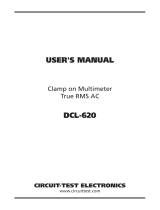2 MM750W-en-GB_v1.2 2/20
Table of contents
Introduction ................................................................................................... 3
FEATURES .......................................................................................................................................... 3
Safety ............................................................................................................. 3
Meter Description ........................................................................................... 6
Control Buttons .............................................................................................. 7
Display Symbols .............................................................................................. 7
Multimeter Operating Instructions .................................................................. 8
AUTORANGING/MANUAL RANGE SELECTION ......................................................................................... 8
MAXIMUM (MAX), MINIMUM (MIN), and MAX minus MIN modes ........................................................... 8
RELATIVE ZERO MODE ......................................................................................................................... 8
LCD BACKLIGHT .................................................................................................................................. 9
DATA HOLD ........................................................................................................................................ 9
AUTO POWER OFF (APO) ..................................................................................................................... 9
LOW BATTERY INDICATION ................................................................................................................... 9
DC VOLTAGE MEASUREMENTS ............................................................................................................ 10
AC VOLTAGE, FREQUENCY, DUTY CYCLE MEASUREMENTS ...................................................................... 10
DC CURRENT MEASUREMENTS ........................................................................................................... 11
AC CURRENT, FREQUENCY, DUTY CYCLE MEASUREMENTS ...................................................................... 12
CLAMP ADAPTOR MEASUREMENTS AC/DC ........................................................................................... 13
RESISTANCE MEASUREMENTS ............................................................................................................ 14
CONTINUITY CHECK ........................................................................................................................... 14
DIODE TEST ...................................................................................................................................... 15
CAPACITANCE MEASUREMENTS .......................................................................................................... 15
TEMPERATURE MEASUREMENTS ........................................................................................................ 16
NCV NON-CONTACT (EF) VOLTAGE MEASUREMENTS ............................................................................. 17
Wireless Communication .............................................................................. 17
WIRELESS COMMUNICATIONS OVERVIEW............................................................................................ 17
INSTALLING A WIRELESS MODULE ....................................................................................................... 17
OBTAINING THE APPLICATION (APP) .................................................................................................... 17
USING THE APPLICATION ................................................................................................................... 18
FCC COMPLIANCE ............................................................................................................................. 19
Maintenance ................................................................................................ 19
BATTERY INSTALLATION ..................................................................................................................... 20
FUSE REPLACEMENT.......................................................................................................................... 20
Specifications ............................................................................................... 21





















